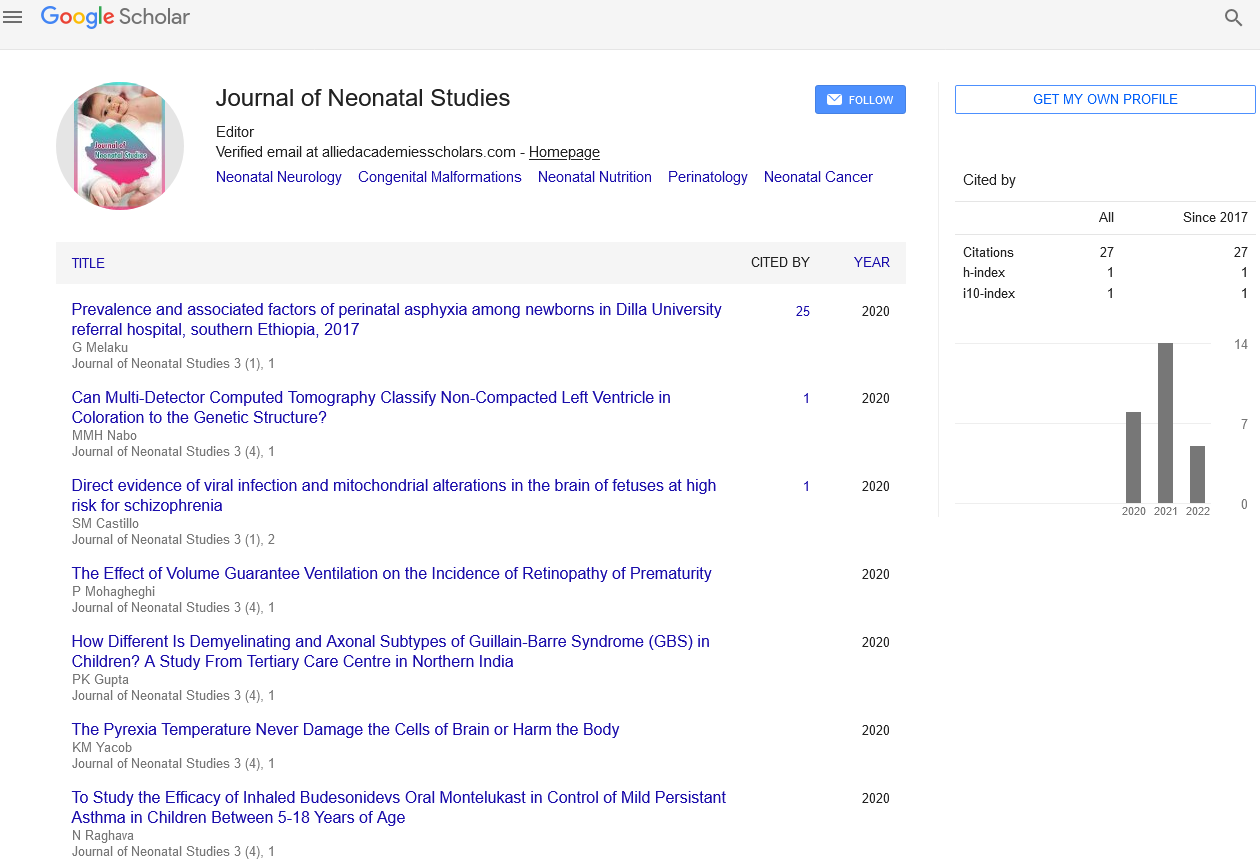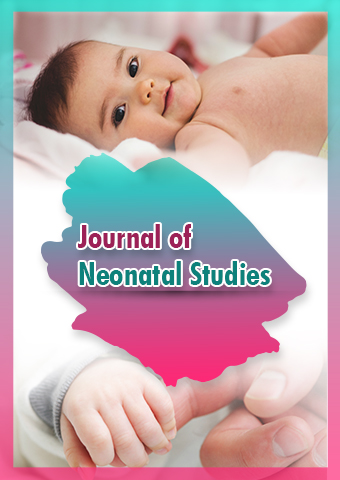Review Article - Journal of Neonatal Studies (2023) Volume 6, Issue 2
Neonatal Rheumatology: Common Neonatal Rheumatic Diseases
Mohri Mussap*
Department of Laboratory Medicine, University Hospital, National Institute for Cancer Research, Largo Rosanna Benzi, Genoa, Italy
Department of Laboratory Medicine, University Hospital, National Institute for Cancer Research, Largo Rosanna Benzi, Genoa, Italy
E-mail: miohri.m@martino.it
Received: 01-Apr-2023, Manuscript No. jns-23-96808; Editor assigned: 03-Apr-2023, PreQC No. jns-22- 96808(PQ); Reviewed: 17-Apr-2023, QC No. jns-22-96808; Revised: 21- Apr-2023, Manuscript No. jns-22- 96808(R); Published: 28-Apr-2023; DOI: 10.37532/jns.2023.6(2).44-46
Abstract
Neonatal rheumatology is a specialized field of medicine that deals with the diagnosis, treatment, and management of rheumatic diseases in infants, particularly those who are less than three months old. Rheumatic diseases are a group of conditions that affect the joints, muscles, and bones of the body, and they can also affect other organs and systems. These conditions can cause pain, inflammation, and other symptoms that can be debilitating and even life-threatening if left untreated. In neonates, rheumatic diseases can be especially challenging to diagnose and manage due to the complexities of their still-developing immune and musculoskeletal systems. Neonatal rheumatology is a subfield of pediatric rheumatology that focuses on the diagnosis and treatment of rheumatic diseases in new-borns and young infants. Rheumatic diseases are a group of conditions that affect the joints, muscles, and bones, and can cause pain, stiffness, and swelling.
Keywords
Neonatal rheumatology • New-born • Infants • Rheumatic diseases • Swelling • Pain
Introduction
The prevalence of neonatal rheumatologic disorders is rare and not well defined. Nevertheless, they are becoming more recognized in the medical field as their diagnosis becomes more available with the advancement of diagnostic tools. The diagnosis of rheumatic diseases in neonates can be challenging because symptoms can be vague, and many diseases have similar clinical presentations. Therefore, physicians must be familiar with the different conditions that can present in the neonatal period to make a timely and accurate diagnosis. The most common neonatal rheumatologic disorder is Neonatal Lupus Erythematosus (NLE), an autoimmune disease that occurs when autoantibodies from the mother cross the placenta and target the baby’s tissues. NLE can cause a range of symptoms, including a characteristic skin rash, liver problems, and blood abnormalities. Treatment of NLE is aimed at managing the symptoms, and in some cases, may require the use of immunosuppressive medications [1-3].
Neonatal rheumatology is a subspecialty of pediatrics that focuses on the diagnosis and treatment of rheumatic diseases in new-borns and infants. Rheumatic diseases are a group of conditions that affect the joints, muscles, and bones, and can lead to inflammation and pain. While rheumatic diseases are commonly associated with adults, they can also occur in children, including infants. In neonatal rheumatology, healthcare providers work to identify and manage these conditions in new-borns and young infants, which can be challenging due to their age and limited ability to communicate symptoms. Common conditions seen in neonatal rheumatology include juvenile idiopathic arthritis, systemic lupus erythematosus, and vasculitis. Effective management of these conditions is critical for promoting healthy growth and development in infants.
Another important neonatal rheumatologic disorder is Juvenile Idiopathic Arthritis (JIA), which can present in the neonatal period. JIA is a chronic autoimmune disease that causes joint inflammation and can lead to joint damage and disability. Early recognition and treatment of JIA are essential to prevent long-term complications, and treatment options include physical therapy, non-steroidal anti-inflammatory drugs, disease-modifying anti-rheumatic drugs, and biologic agents. Other rare neonatal rheumatologic disorders include Neonatal-Onset Multisystem Inflammatory Disease (NOMID), which causes recurrent fevers, skin rash, and joint pain; congenital myopathies, which are genetic muscle disorders that can cause weakness and stiffness; and infantile scleroderma, which causes hardening and thickening of the skin [4].
Discussion
Importance of early diagnosis
Early diagnosis and intervention are critical in neonatal rheumatology. Delayed diagnosis and treatment can lead to serious complications such as joint damage, growth retardation, and developmental delays. Furthermore, rheumatic diseases in neonates can often present with non-specific symptoms, which can make it difficult for healthcare providers to identify the underlying condition. Therefore, it is important to have a high index of suspicion and to consider rheumatic diseases in the differential diagnosis of neonates with non-specific symptoms.
Types of Neonatal Rheumatic diseases
There are several types of rheumatic diseases that can affect neonates. Some of the most common ones include:
Juvenile Idiopathic Arthritis (JIA): This is a type of arthritis that affects children under the age of 16. It can cause joint pain, stiffness, swelling, and fever. JIA can also affect other organs and systems in the body, such as the eyes and skin.
Systemic Lupus Erythematosus (SLE): SLE is an autoimmune disease that can affect multiple organs and systems in the body. It can cause a wide range of symptoms such as joint pain, fatigue, fever, and skin rashes. In neonates, SLE can present with symptoms such as anemia, thrombocytopenia, and liver dysfunction.
Dermatomyositis: Dermatomyositis is a rare autoimmune disease that can cause muscle weakness and skin rashes. It can also affect other organs and systems in the body such as the lungs and heart.
Systemic sclerosis: Systemic sclerosis is a rare autoimmune disease that can cause skin thickening, joint pain, and organ damage. In neonates, it can present with symptoms such as growth retardation and gastrointestinal dysfunction [5].
Diagnosis and Treatment
Diagnosing neonatal rheumatic diseases can be challenging due to the non-specific nature of the symptoms. However, a thorough physical examination and a detailed medical history can provide important clues that can help with the diagnosis. Diagnostic tests such as blood tests, X-rays, and ultrasound can also be helpful in confirming the diagnosis.
Treatment for neonatal rheumatic diseases typically involves a combination of medications and physical therapy. Medications such as Non- Steroidal Anti-Inflammatory Drugs (NSAIDs) and corticosteroids can help relieve pain and inflammation. Disease-Modifying Anti- Rheumatic Drugs (DMARDs) may also be used to slow the progression of the disease and prevent joint damage [6, 7].
Physical therapy can also be helpful in improving joint mobility and muscle strength. This can include exercises, stretching, and massage therapy. Occupational therapy can also be helpful in improving the ability to perform daily activities such as dressing and eating.
Prognosis: The prognosis for neonatal rheumatic diseases can vary depending on the specific condition and the severity of the symptoms. However, with early diagnosis and appropriate treatment, many neonates with rheumatic diseases can lead normal, healthy lives. In some cases, the disease may go into remission, while in other cases, the symptoms may persist into adulthood.
Neonatal rheumatology is a complex and challenging field that requires a multidisciplinary approach to diagnosis and management. The rarity of these disorders highlights the importance of collaboration among pediatric rheumatologists, neonatologists, geneticists, and other specialists to provide the best possible care for affected infants. As diagnostic tools improve and our understanding of the pathogenesis of these conditions deepens, we can hope to improve outcomes for these vulnerable patients. Neonatal rheumatology is an important field of medicine that focuses on the diagnosis, treatment, Neonatal rheumatology is a complex and evolving field that deals with the diagnosis and management of rheumatic disorders in neonates, infants, and young children. The most common rheumatic diseases in this age group include juvenile idiopathic arthritis, systemic lupus erythematosus, and dermatomyositis. The early recognition and diagnosis of these conditions are essential to prevent long-term complications and improve outcomes [8].
Conclusion
Advances in the field of neonatal rheumatology have led to significant improvements in the management of these conditions. Biologic agents, including tumor necrosis factor inhibitors and interleukin inhibitors, have revolutionized the treatment of juvenile idiopathic arthritis and other rheumatic diseases. Moreover, advances in genetics and genomics have improved our understanding of the underlying pathophysiology of these conditions, enabling targeted therapies and personalized medicine. Neonatal rheumatology is an essential subspecialty in pediatric rheumatology that focuses on the diagnosis and management of rheumatic diseases in neonates, infants, and young children. Early recognition, accurate diagnosis, and prompt treatment are essential for improving outcomes and preventing long-term complications. Advances in genetics, genomics, and targeted therapies offer new opportunities to improve the management of these conditions in the future [9, 10].
Acknowledgement
None
Conflict of Interest
None
References
- Kuliev Anver. Verlinsky Yury. Preimplantation diagnosis: A realistic option for assisted reproduction and genetic practice. Curr Opin Obstet Gynecol. 17, 179-183 (2005).
- Williams TN. Obaro SK Sickle cell disease and malaria morbidity: a tale with two tails. Trends in Parasitology. 27, 315-320 (2011).
- Kumar Pankaj, Radhakrishnan Jolly, Chowdhary MA et al. Prevalence and Patterns of Presentation of Genetic Disorders in a Pediatric Emergency Department. Mayo Clinic Proceedings. 76, 777-783 (2001).
- Schellenberg ES, Dryden DM, Vandermeer B et al. Lifestyle interventions for patients with and at risk for type 2 diabetes: a systematic review and meta-analysis. Annals of Internal Medicine. 159, 543-551 (2013).
- O'Gorman DJ, Krook A. Exercise and the treatment of diabetes and obesity. Med Clin N. 95, 953-969 (2011).
- Koutroumpakis E, Jozwik B, Aguilar D et al. Strategies of Unloading the Failing Heart from Metabolic Stress. Am J Med. 133, 290-296 (2020).
- Wild S, Roglic G, Green A et al. Global prevalence of diabetes: estimates for the year 2000 and projections for 2030. Diabetes Care. 27, 1047-1053 (2004).
- Carulli L, Rondinella S, Lombardini S et al. Review article: diabetes, genetics and ethnicity. Aliment Pharmacol Ther. 22, 16-19 (2005).
- Abate N, Chandalia M. Ethnicity and type 2 diabetes: focus on Asian Indians. JDC. 15, 320-327 (2001).
- Cvetković RS, Plosker GL. Exenatide: a review of its use in patients with type 2 diabetes mellitus (as an adjunct to metformin and/or a sulfonylurea). Drugs. 67, 935-954 (2007).
Indexed at, Google Scholar, Crossref
Indexed at, Google Scholar, Crossref
Indexed at, Google Scholar, Crossref
Indexed at, Google Scholar, Crossref
Indexed at, Google Scholar, Crossref
Indexed at, Google Scholar, Crossref
Indexed at, Google Scholar, Crossref
Indexed at, Google Scholar, Crossref

